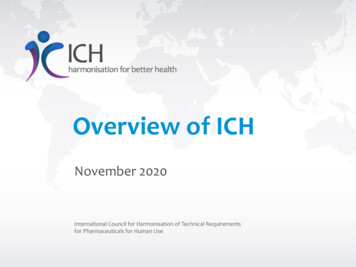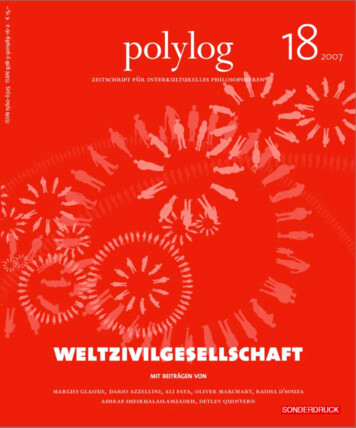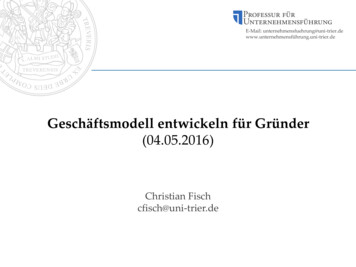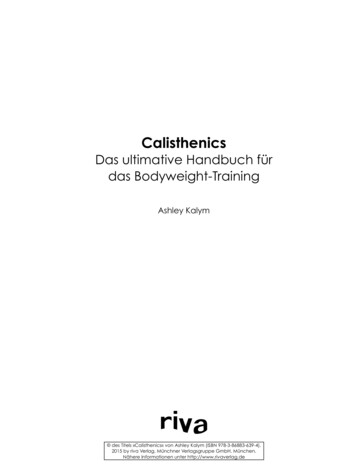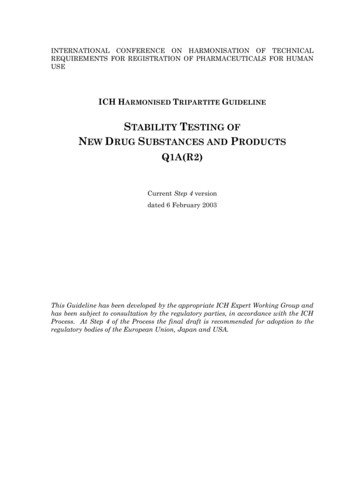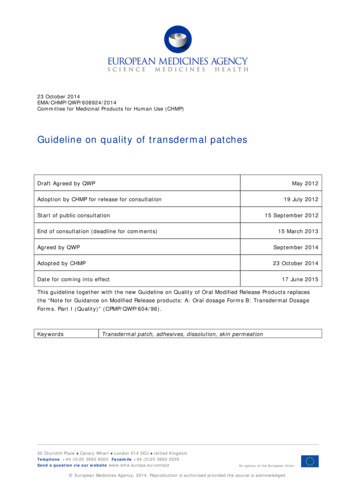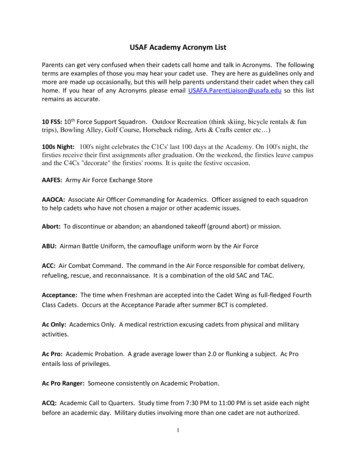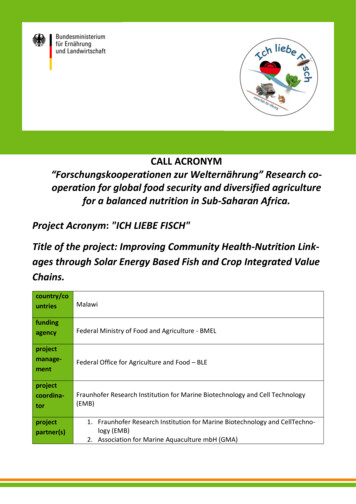
Transcription
CALL ACRONYM“Forschungskooperationen zur Welternährung” Research co‐operation for global food security and diversified agriculturefor a balanced nutrition in Sub‐Saharan Africa.Project Acronym: "ICH LIEBE FISCH"Title of the project: Improving Community Health‐Nutrition Link‐ages through Solar Energy Based Fish and Crop Integrated deral Ministry of Food and Agriculture ‐ BMELprojectmanage‐mentFederal Office for Agriculture and Food – r Research Institution for Marine Biotechnology and Cell Technology(EMB)1. Fraunhofer Research Institution for Marine Biotechnology and CellTechno‐logy (EMB)2. Association for Marine Aquaculture mbH (GMA)
Page 2 of 103. Lilongwe University of Agriculture & Natural Resources, Aquaculture andFisheries Science Department (LUANAR‐AQF)4. Lilongwe University of Agriculture & Natural Resources, Department of Hu‐man Nutrition and Health (LUANAR‐HNH)5. Lilongwe University of Agriculture & Natural Resources, Department ofFood Science and Technology (LUANAR‐FST)6. Quantum for Urban Agriculture and Environmental Sanitation (QUALIVES)7. Innovative Fish Farmers Network Trust (IFFNT)projectbudget1.708.071,20 project du‐ration1st of. March 2016 – 31st of December 2020key wordsAquaculture, aquaponics, solar powered hatchery, fish breeding programs, hybridi‐sation, fish, fish larvae, fish seedlings, tilapia, chambo, "all‐male" populations, fishfeed, insect proteins, integrated aqua‐agriculture (IAA), vegetable production,health status, social status, malnutrition, food diversity, capacity building, training,cooking classes, networksback‐groundTraditionally Malawi is a nation where a lot of fish has been consumed. However,the main foodstuff has now become corn porridge (Nsima). The overfishing of LakeMalawi since the beginning of the 1990s has resulted in fish in general being hardlyaffordable for most people in Malawi. Especially the most desired tilapia species O.karongae, "Chambo" in the national language, got too expensive. Against this back‐ground, the primary objective of the "I love fish" project was to improve the supplyof fish and vegetables to the rural population and to increase the added value. Thiswas intended to improve food security and the health status of the village commu‐nities involved and to expand their earning potential. The project has also addres‐sed another significant problem area, which is the bad quality of local fish feed forgrowing and adult fish. One option is the production of insect larvae, which can beused in Malawi for the production of very cheap but valuable animal protein. Thisapproach is now being pursued in the last project year until the end of 2020.In detail, the focus was on the following project objectives:i.ii.objectiveiii.iv.Improvement of the production of native tilapia species through more effi‐cient rearing conditions and the production of "all male" fingerlingsthe construction of a solar powered larval rearing facility to improve thesupply of juvenile fish, especially O. karongae (Chambo)the implementation of integrated aqua‐agriculture (IAA) in order to use theexcrements produced by fish in the ponds as nutrients for plant breeding byirrigation with pond water.the introduction and dissemination of aquaponics technology in Malawi (in‐tegrated fish and vegetable farming in circulating systems)
Page 3 of 10v.vi.vii.viii.the production of high‐quality proteins from the rearing of BSF larvae fromorganic residues to produce high quality but low‐cost fish feedthe implementation of training courses to provide expert knowledge andcapacity building in rural communitiesthe study of the health status and nutritional habits of families in rural ar‐eas, especially those of children and elderly people, before and after the im‐plementation of the project measuressupporting the establishment of a network and knowledge platform to pro‐mote the exchange between the different municipalities and thus ensurethe sustainability of the project even beyond the projects life time.The most important project results:i.resultsii.iii.iv.The installation and commissioning of the first solar power‐supportedhatchery in Malawi for the intensive rearing of low‐cost fish seedlings forrural fish farmers has been successfully completed. In the second breedingseason the hatchery has already produced seedlings close to the initially es‐timated production capacity (0.75 million) and could be operated continu‐ously without disturbances except for a technical failure of the inverter(warranty repair). The seedling production of Bunda College Farm could al‐ready be increased by 40% in the 2019/20 season due to the hatchery. Byoptimizing the processes, a production of more than 1 mill. seedlings perhatching season is possible. The hatchery also supports the breeding of ti‐lapia hybrids, focusing on the production of "all male" cohorts, as these usethe feed more efficiently and grow faster.Some of the farmers who participated in the training course for the opera‐tion of the hatchery are now building small hatcheries of their own, follow‐ing the same pattern as the one built by the project, and want to produceseedlings as an additional source of income and sell them in the local area.The training courses on optimised pond management and the support withmaterials and feed have led to a 4‐7‐fold increase in the efficiency of fishproduction per season, depending on the region. The breeding selection re‐sults have contributed to an increase in fish production.The implementation of training courses for integrated aqua‐agriculture(IAA), when applied consistently, has led to a significant improvement invegetable production among rural aquaculture farmers. In the village com‐munities participating in the project, the evaluation of the data from theendline survey revealed a significantly higher standard of living comparedwith the data from the baseline survey.
Page 4 of 10v.vi.vii.viii.ix.x.xi.Several training courses were conducted on the topics of wholefood nutri‐tion and the production of new products from fish, especially for childrenand adolescents. In addition to women, men from the community councilsand also school children participated in the training. In practical exercises itwas shown which different foods can be produced from fish, maize and cas‐sava in order to improve the acceptance of fish and thus the nutritional con‐ditions, especially among small children. Through these measures, a consid‐erable increase in the nutritional diversity available to the participating vil‐lage communities was achieved.On the farm of Bunda College and at Benga Parish (missionary community)in the district of Nkhotakota two aquaponic plants were built and put intooperation. In addition to the simple barrelponics system (aquaponics sys‐tem made of plastic barrels), which was built and tested during the project,the two large systems now produce vegetables and fish in routine opera‐tion. The systems are also used for training purposes. Training courses wereheld in March 2019 and June 2019, more are to follow.The aquaponic technology has raised great interest in Malawi in connectionwith the training courses. The master student trained in the aquaponicsproject has founded a start‐up company to advise and support farmers inMalawi in the installation and operation of aquaponic systems. Aquaponictechnology is particularly suitable in Malawi for growing vegetables in thedry season. The water requirement is only about 5% compared to tradi‐tional vegetable growing in fields.Expanded clay balls are the optimal substrate for the plant beds in an aqua‐ponic plant. As this type of substrate is not available in Malawi and wouldhave to be imported, the project initiated an expanded clay ball production.With the production techniques developed by the project at Benga Parish,expanded clay balls are now produced by a small cooperative in the Nkhota‐kota district and sold at a fraction of the import price.Within the scope of the project "I love fish" 4 master theses and a disserta‐tion were produced.In addition to the village communities originally selected in the project, itwas possible, albeit to a lesser extent, to involve other farmers in the train‐ing courses and to establish new networks between the village communitiesand individual farmers. For example, the project attracted the attention of aGerman/Malawian couple in Nkhandwe Village in the Nkhotakota districtthrough the project s website. They run the "Nkhotakota Pottery Lodge"and feel committed to improving the living conditions of the surroundingvillagers. A group of farmers from the village community was invited to at‐tend the training courses on solar‐powered aquaculture and healthy nutri‐tion. Furthermore, contact was made with an experienced farmer (Mr.Mysali) and he was more intensively involved in the project, as he had al‐ready worked with IAA in the past and was therefore able to tell the localfarmers first‐hand about the advantages of this technology during a net‐work meeting.Other network partners and external (voluntary) supporters of the project:
Page 5 of 10 The director of the national office of the NGO "Welthungerhilfe", JohannesKaltenbach, contacted the project in November 2018 to inform himself aboutthe work done until then. Possibly the "Welthungerhilfe" will take up the bar‐relponic systems as an option and support the construction of such systems insome villages.Mrs. Brit Hartmann from the association abacus e.V. from Rostock contactedthe project via EMB. The association is also active in Malawi, more precisely atBenga Parish, through a project sponsored by the Federal Institute for Voca‐tional Education and Training, and sent a trainee to support the work at BengaParish in 2019. It was agreed that he would also support the "I love fish" pro‐ject work. This trainee facilitated significantly the compilation of the aquaponicsystem at Benga perish.The project contacted representatives of GIZ (Deutsche Gesellschaft für Inter‐nationale Zusammenarbeit GmbH), who are also active in the field of aquacul‐ture in Malawi. An employee of GIZ took part in one of the workshops on aq‐uaculture and intensive larvae rearing of endemic tilapia species in the solarpowered indoor hatchery.Furthermore, there is contact to employees of the organisation World Fish,who informed themselves about the contents of the project and visited thehatchery at Bunda College.At the end of 2018, a contact was established with a potential volunteer (Thor‐sten Knörr), who, inspired by the ZDF documentary about the project, had ap‐plied to work in the "I love fish" project. In cooperation with Benga Parish itwas then possible to send this volunteer to the mission for about two months.Mr. Knörr made great contributions to the project and the Parish from June tothe beginning of August 2019. Among other things, he took up the idea of pro‐ducing the expanded clay ball substrate in Malawi for the plant beds of the aq‐uaponic systems and established a clay ball production at Benga Parish.Recommendations resulting from the experiences in the project:i.recom‐menda‐tionsii.The cooperation with Benga Parish (Missionary Community of Saint Paul theApostle from the Diocese of Lodwar) has proved to be extremely helpfuland fruitful in the course of the project; in future projects, the formation ofnetworks involving institutions such as NGOs, development aid organisa‐tions or governmental organisations of the respective countries should begiven even greater emphasis.The involvement of participating communities should be undertaken at anearlier stage, during the project planning. The participating communitiesshould be involved in the planning and thus be motivated to support the im‐plementation of the measures more strongly.
Page 6 of 10iii.iv.A fundamental problem in sub‐Saharan Africa that goes beyond the achiev‐able goals of this project is the loss of food through rotting. The FAO esti‐mates that about 37% of food is lost to consumption due to a lack of preser‐vation methods. Since the rural population in Malawi does not have refrig‐eration or freezing facilities, there is almost no possibility to preserve foodfor a longer period of time. Due to the high seasonality, fruits and vegeta‐bles in particular are only available for a short time. Another important steptowards a safe basic supply of healthy food is therefore the implementationof preservation methods in Malawi. This would have several positive as‐pects, such as the production of jams and sun‐dried fruits which could notonly be produced for own consumption, but could also be sold. Fresh fishthat is only available for a short time after harvesting could be preserved fora longer period. In addition, the daily expenditure of time for the procure‐ment of fresh food could be reduced. Especially against the background ofthe expected negative consequences of the Corona Pandemic for develop‐ing countries like Malawi, such measures, which support the storage of foodthrough preservation techniques are very helpful and urgently needed.In connection with item iii, requirement analyses are recommended for theadequate supply of essential micronutrients such as vitamins and minerals,and measures are recommended to close the resulting supply gaps.illustrati‐onsFig. 1: Changes in the productivity of the participating fishclubs in Nkhotakota andMchinji over the project 3‐year lifespan. The farmer in Mchinji were ahead withtheir experience in aquaculture at the commencement date of the project comparedto the farmer in Nkhotakota.
Page 7 of 10Fig. 2: Changes in ownership of assets in the households targeted by the "Ich LiebeFisch"‐Project.Fig. 3: Percentage of households achieving high dietary diversity at end line com‐pared to baseline among households in target communities.photos
Page 8 of 10Von links nach rechts: Vorlesungen im Trainingskurs zum Betrieb der Brutfischanlage am Vormittag."Hands on"‐Training. Teilnehmer bestimmen die Wasserqualität in der Hatchery (Ammonium, Nitrit,Nitrat, pH). Messung von Sauerstoff und Temperatur.Von links nach rechts: Setzlinge für die Teiche der Farmer von der Bunda Farm. Transport der Setz‐linge zu den Teichen der Farmer. Temperaturanpassung der Transportbeutel vor dem Aussetzen.Von links nach rechts: Das Aquaponicsystem auf dem Gelände der Farm vom Bunda College. Blick überdie Pflanzenbetten kurz nach dem Aufbau (noch ohne Substrat). Trainingskurs in Aquaponic, hier De‐monstration der Barrelponics‐Variante.Von links nach rechts: Gruppenbild mit den Farmern die an der Exkursion zu der Farm von Mr. Mysaliteilgenommen haben. Mr. Mysali berichtet über seine Erfahrungen mit Fischzucht und IAA. NebenFisch werden auf der Farm auch Gemüse und Früchte produziert und mit Teichwasser gedüngt.
Page 9 of 10Oben, von links nach rechts: Anpassung der Tanks für den Pumpensumpf der Aquaponicanlage. Wielinks oben. Tonkugelproduktion mit Dorfmitgliedern auf dem Gelände vom Benga Perish. 2.Reihe vonoben, von links nach rechts: Aufstellung der Pflanzenbetten. Optimierter Brennofen für die Tonku‐geln. Aquaponicanlage mit Pflanzenbetten aus im Benga Perish produzierten Blähtonkugeln.3.Reihe von oben, von links nach rechts: Volontär T. Knörr mit Mitarbeitern des Benga Parish. Volon‐tär vom Verein abacus e.V. aus Rostock bei der Schulung von Mitarbeitern des Benga Parish. Fertigkonfigurierte Aquaponicanlage. Aquaponicanlage im Benga Parish. 4.Reihe von oben, von links nachrechts: Kontrolle des Pflanzenwachstums in der Aquaponicanlage. Trainingskurs Aquaponic in derAnlage am Benga Parish. Gesunde Gemüsepflanzen im Pflanzenbett aus Tonkugeln (Mustard‐Blät‐ter, Mpriru, das erste Mal unter Aquaponicbedingungen aufgezogen).Von links nach rechts: Abschlussmeeting zum ersten Abschnitt des "Ich liebe Fisch"‐Projekts Ende Sep‐tember 2019, mit einem symbolischen Handschlag zur Übergabe der Hardware zwischen Ariana Bystry(Projektadministration, BLE) und Dr. Agnes Mwangwera (Bunda Campus Director). Gespräche zwi‐schen den Dorfbewohnern und Ariana Bystry sowie mit einem Distrikt‐Fischereibeamten (rechts, Dr.Rakers, A. Bystry).
Page 10 of 10Von links nach rechts: Fischernte in einer Partnercommunity im Mjinchi‐District (Chikondi Fisch‐Club).Die Fische werden stichprobenartig vermessen und die Messungen für die weitere Auswertung sofortdigitalisiert. Typische Grösse der geernteten Fische bei dieser Community nach einer 5‐6‐monatigenAbwachsperiode (etwa 120‐170g). Das Bild zeigt einen O. shiranus.Von links nach rechts: Fischernte in einer Partnercommunity im Mjinchi‐District (Chikondi Fisch‐Club).Ein Junge freut sich über einen Fisch den er beim Abfischen im Ablaufgraben gefangen hat. Der Schatz‐meister des Fisch‐Clubs zählt seine Einnahmen vom Fischverkauf. Frischer Fisch für die Dorfbewohner.
Page 3 of 10 v. the production of high‐quality proteins from the rearing of BSF larvae from organi
